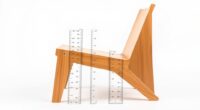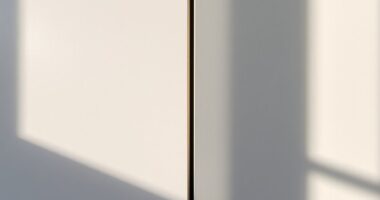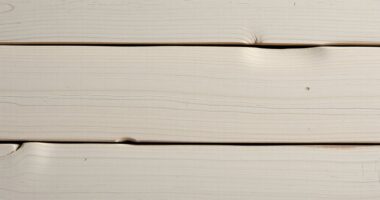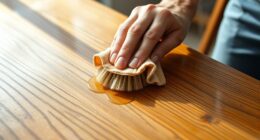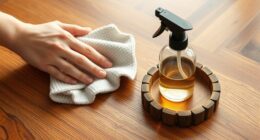To create an aged look with paint, start with distressing techniques like sanding edges and corners to reveal underlying layers, giving a worn appearance. Use chalk paint for a matte, vintage finish, and soften edges with a damp cloth or sandpaper. Applying wax or glaze adds depth and dimension, while gradual paint removal enhances authenticity. Combining these methods results in a charming, weathered look that adds character—if you want to master each step, there’s more to discover.
Key Takeaways
- Use sanding or damp cloth to selectively wear edges and surfaces, revealing underlying layers for a weathered effect.
- Apply chalk paint for a soft, matte finish and lightly sand or wipe to create a naturally aged look.
- Highlight specific areas with distressing techniques to mimic natural wear and add authenticity.
- Combine distressing with paint chalking and glazing to enhance depth and create layered, vintage appearances.
- Work gradually, removing small amounts of paint to control the aged effect and achieve a believable, charming patina.
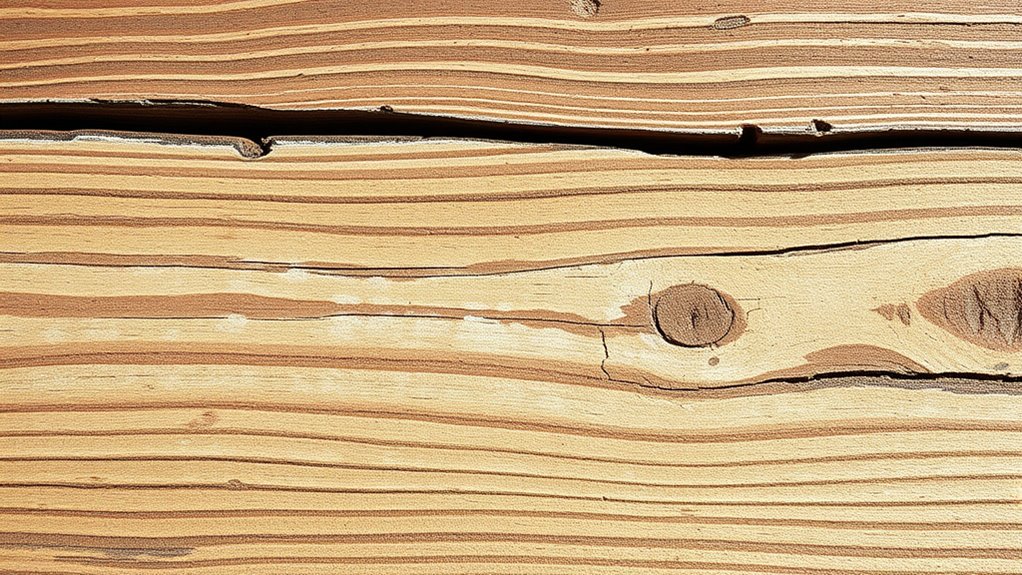
Have you ever wondered how artists create aged, vintage effects on their projects? The secret lies in a variety of distressing techniques that give furniture and decor pieces a charming, weathered look. One of the most popular methods is furniture distressing, which involves intentionally wearing down surfaces to mimic the natural aging process. When you’re doing furniture distressing, you might start by sanding edges and corners, revealing layers of paint underneath and creating a sense of history. This technique allows you to highlight certain areas, making the piece look like it’s been used and loved over time. To achieve an authentic aged appearance, you often combine distressing with paint chalking, a method where chalk-like residues are applied and then wiped away to soften the finish and add a matte, vintage effect.
Paint chalking is especially useful for creating a subtle, muted finish that resembles chalkboard surfaces or old paint layers. When you apply chalk paint, you don’t need to prime or sand extensively, which makes it user-friendly for beginners. Once the chalk paint dries, you can distress it further by lightly sanding or applying a damp cloth to remove parts of the paint, revealing the layers underneath. This process enhances the textured, aged look and helps your piece feel more authentic. The beauty of paint chalking is that it’s versatile; you can use it on furniture, picture frames, or decorative accents. Its matte, velvety finish lends a vintage charm that’s hard to achieve with glossy paints.
Additionally, understanding legislative changes related to aging techniques can help you stay compliant with safety standards or discover new methods approved for commercial use. You can intensify the aged effect by combining furniture distressing and paint chalking. For example, after applying chalk paint, you might sand specific areas or edges to simulate natural wear. Alternatively, you can use a wax or glaze to deepen crevices and add depth to the finish. The key is to work gradually, removing small amounts of paint until you reach the desired look. Remember, the goal isn’t perfection but rather a believable, timeworn aesthetic that tells a story. Whether you’re updating an old piece of furniture or creating a vintage-inspired décor item, these techniques allow you to customize your project and achieve stunning results.
Frequently Asked Questions
What Safety Precautions Should I Take When Distressing Furniture?
When distressing furniture, you should always wear safety gear like gloves, masks, and goggles to protect your skin and eyes from dust and paint fumes. Make certain good ventilation by working in a well-ventilated area or opening windows and doors, which helps disperse harmful fumes. Keep your workspace tidy, and wash your hands after finishing. Taking these precautions keeps you safe while achieving your desired aged look.
Can Distressing Techniques Be Applied to Outdoor Surfaces?
Yes, you can apply distressing techniques to outdoor surfaces, but you need to take into account weather conditions and material compatibility. Make sure the paint and distressing products are suitable for outdoor use to withstand rain, sun, and temperature changes. Apply a weather-resistant sealant afterward to protect your work. Check the manufacturer’s recommendations to ensure your chosen materials will hold up well over time and won’t peel or fade prematurely.
How Do I Choose the Right Paint for Distressing?
When choosing the right paint for distressing, focus on paint color selection and finish types. Opt for matte or chalk finishes to make distressing easier and more authentic. Select colors that complement your desired aged look, such as muted tones or contrasting shades to highlight distressing areas. Test small sections first to see how the paint reacts when distressed. This way, you guarantee your project achieves the perfect vintage, worn-in appearance you want.
What Tools Are Best for Achieving Different Distressed Effects?
You’ll want a variety of tools to master different distressed effects. For a chalk finish, use soft brushes or a lint-free cloth to gently layer and wipe away paint for a vintage look. Sandpaper grit varies: fine grit creates subtle wear, while coarse grit gives bold, rustic textures. Ironically, the right tools—like a palette knife or steel wool—can turn simple techniques into artful imperfections, making your piece look perfectly aged.
How Can I Seal or Protect Distressed Painted Surfaces?
To seal or protect your distressed painted surfaces, you should choose the right sealant options or protective finishes. Clear polyurethane or polyurethane varnish offers durable protection, while wax provides a softer, matte finish. Apply these with a brush or cloth, following the manufacturer’s instructions. Make sure the paint is fully dry first. This will help preserve your aged look and keep the surface resistant to scratches, moisture, and wear.
Conclusion
So, next time you want your furniture to look effortlessly vintage, remember, it’s all about deliberately ruining it. That’s right—what seems like damage is actually art. You spend hours distressing, sanding, and painting, all to create an aged look that screams “I’ve been around forever.” Ironically, the more you try to fake age, the more you prove how much effort it takes to make something look effortlessly worn. Happy aging your pieces!

